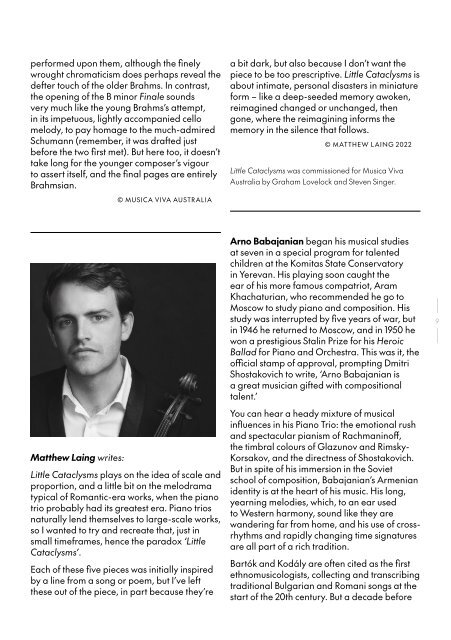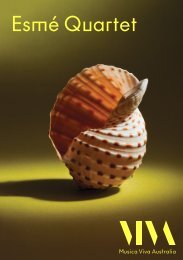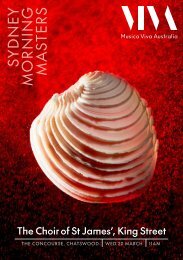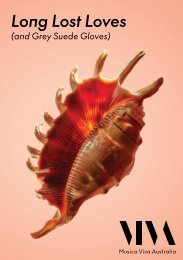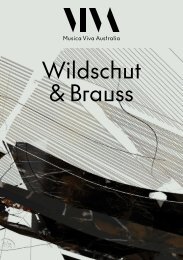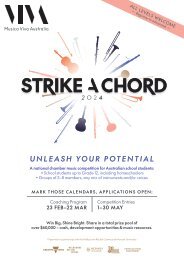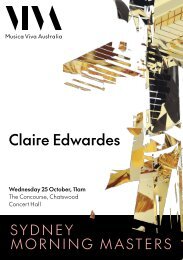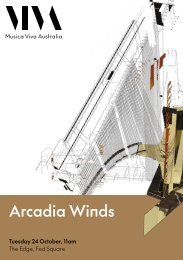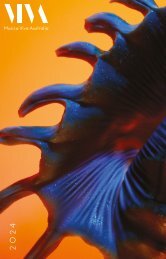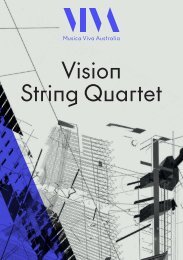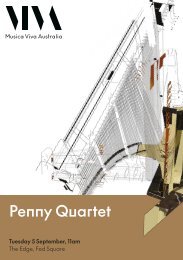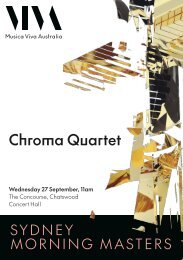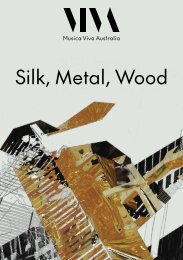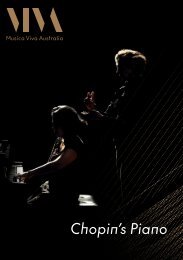Z.E.N. Trio Program Guide | August 2022
Create successful ePaper yourself
Turn your PDF publications into a flip-book with our unique Google optimized e-Paper software.
performed upon them, although the finely<br />
wrought chromaticism does perhaps reveal the<br />
defter touch of the older Brahms. In contrast,<br />
the opening of the B minor Finale sounds<br />
very much like the young Brahms’s attempt,<br />
in its impetuous, lightly accompanied cello<br />
melody, to pay homage to the much-admired<br />
Schumann (remember, it was drafted just<br />
before the two first met). But here too, it doesn’t<br />
take long for the younger composer’s vigour<br />
to assert itself, and the final pages are entirely<br />
Brahmsian.<br />
a bit dark, but also because I don’t want the<br />
piece to be too prescriptive. Little Cataclysms is<br />
about intimate, personal disasters in miniature<br />
form – like a deep-seeded memory awoken,<br />
reimagined changed or unchanged, then<br />
gone, where the reimagining informs the<br />
memory in the silence that follows.<br />
© MATTHEW LAING <strong>2022</strong><br />
Little Cataclysms was commissioned for Musica Viva<br />
Australia by Graham Lovelock and Steven Singer.<br />
© MUSICA VIVA AUSTRALIA<br />
Arno Babajanian began his musical studies<br />
at seven in a special program for talented<br />
children at the Komitas State Conservatory<br />
in Yerevan. His playing soon caught the<br />
ear of his more famous compatriot, Aram<br />
Khachaturian, who recommended he go to<br />
Moscow to study piano and composition. His<br />
study was interrupted by five years of war, but<br />
in 1946 he returned to Moscow, and in 1950 he<br />
won a prestigious Stalin Prize for his Heroic<br />
Ballad for Piano and Orchestra. This was it, the<br />
official stamp of approval, prompting Dmitri<br />
Shostakovich to write, ‘Arno Babajanian is<br />
a great musician gifted with compositional<br />
talent.’<br />
|<br />
9<br />
|<br />
Matthew Laing writes:<br />
Little Cataclysms plays on the idea of scale and<br />
proportion, and a little bit on the melodrama<br />
typical of Romantic-era works, when the piano<br />
trio probably had its greatest era. Piano trios<br />
naturally lend themselves to large-scale works,<br />
so I wanted to try and recreate that, just in<br />
small timeframes, hence the paradox ‘Little<br />
Cataclysms’.<br />
Each of these five pieces was initially inspired<br />
by a line from a song or poem, but I’ve left<br />
these out of the piece, in part because they’re<br />
You can hear a heady mixture of musical<br />
influences in his Piano <strong>Trio</strong>: the emotional rush<br />
and spectacular pianism of Rachmaninoff,<br />
the timbral colours of Glazunov and Rimsky-<br />
Korsakov, and the directness of Shostakovich.<br />
But in spite of his immersion in the Soviet<br />
school of composition, Babajanian’s Armenian<br />
identity is at the heart of his music. His long,<br />
yearning melodies, which, to an ear used<br />
to Western harmony, sound like they are<br />
wandering far from home, and his use of crossrhythms<br />
and rapidly changing time signatures<br />
are all part of a rich tradition.<br />
Bartók and Kodály are often cited as the first<br />
ethnomusicologists, collecting and transcribing<br />
traditional Bulgarian and Romani songs at the<br />
start of the 20th century. But a decade before


